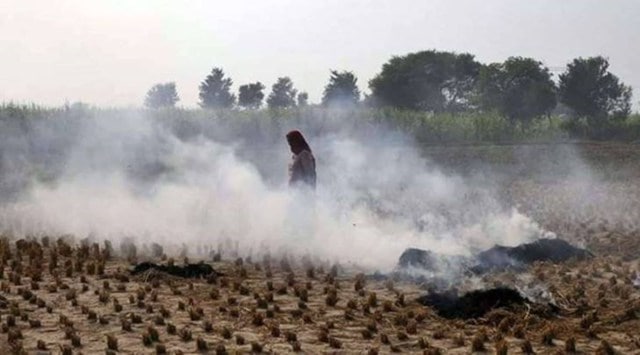- India
- International
With 2,035 incidents, Amritsar breaks 5-year stubble burning record
Maximum stubble fires in the state this season have been recorded in Tarn Taran (3,561). But despite this, AQI in Punjab’s cities stays between ‘poor’ and ‘moderate’.
 In Punjab, stubble burning takes place every year in 17-18 lakh hectares.
In Punjab, stubble burning takes place every year in 17-18 lakh hectares.As Punjab recorded 23,177 stubble fires till October 29 against 16,734 last year during the same period, Amritsar broke its five-year record of maximum stubble fires in a season by recording 2,035 field burning incidents till Thursday. The previous high was 1,788, which was set by the district in 2016 (when Punjab Remote Sensing Centre started recording the stubble fires through satellite). However, maximum stubble fires in the state this season have been recorded in Tarn Taran (3,561). But despite this, AQI in Punjab’s cities stays between ‘poor’ and ‘moderate’.
However, according to the data sourced from the Central Pollution Control Board (CPCB), there were seven cities across the country which recorded the worst AIQ on Thursday out of which five cities/towns were in Haryana. Haryana’s Dharuhera on Thursday had the worst AQI in the whole country. Dharuhera, which is a town located in Rewari district but falls under Delhi NCR and is a big industrial hub, recorded ‘severe’ AQI of 427. Dharuhera was followed by another city of Haryana in the list — Charkhi Dadri, which recorded 418 AQI, while Jind, Bhiwadi, Bahadurgarh recorded 405, 404 and 402 AQI, respectively.
Apart from these two cities of Uttar Pradesh’s Greater Noida and Baghpat also recorded ‘severe’ AQI of 412 and 403, respectively, on Thursday.
Meanwhile in Punjab, 50 per cent cities recorded ‘moderate’ AQI and 50 per cent had ‘poor’ AQI on Thursday. Amritsar (216), Patiala (221), Ludhiana (226) and Khanna (242) recorded ‘poor’ AQI, while Bathinda, Jalandhar, Mandi Gobindgarh, Roop Nagar recorded ‘moderate’ AQI.
Meanwhile, despite several fires being recorded across Punjab, no pro-active role is being played by the 8,000 nodal officers appointed in the state before the harvesting season. They are just verifying the fires after getting messages from the Punjab Remote Sensing Centre and uploading the details of the fires on the App whether the stubble fires or not.

In Punjab, there are over 13,000 villages out of which paddy is sown in around 10,500 villages, including in small areas in over 1,000 villages. Effectively 9,500 villages are the main paddy villages. The government had appointed 8,000 nodal officers for these villages. One nodal officer is for one village but where the size of villages is small, one nodal officer looks after the two villages also.
Member Secretary, Punjab Pollution Control Board (PPCB), Krunesh Garg informed that nodal officers are visiting the fire incident sites physically to verify the fire and imposing environmental compensation.
But despite deputing nodal officers in such large numbers across the state, Amritsar’s paddy stubble burning cases this year stand at 2,032, compared to 1,510 in 2019, 1,151 (2018), 999 (2017) and 1,788 (2016) in years prior to that. Similarly, Tarn Taran district too has recorded 3,561 stubble burning cases in this season which are highest in past four years including 3,373, 2,420, and 2,085 in the years 2019, 2018, and 2017, respectively.
There were total and 3,619 burning incidents in the district in 2016. But the district certainly will cross this mark because the paddy harvesting season on its peak in Punjab.
A senior officer in the Punjab Agriculture Department said that in some districts the farmers are deliberately burning the fields to express their anger against Centre’s agri Acts and they could not fine them or book under cases.
Till October 28, Punjab Pollution Control Board (PPCB) has imposed Rs 85.76 lakh environmental compensation in 3,171 cases while 2,696 cases have been identified after physical visits in which the compensation will be imposed in a day or so. PPCB has also recovered Rs 2.07 lakh compensation from farmers till Wednesday. In 2,489 cases ‘red entry’ has been made in ‘khasra girdawari’ (cultivation register) of the land in which fire has taken place which means that it will come in permanent revenue record for future reference as well as that the farmer was a violator. Apart from this, 55 cases have been registered under various Acts including in 39 cases prosecution filed under Section 39 of Air Act, 1981, and in 16 cases FIR has been filed under Section 188 of IPC. In 17 cases, environment compensation has been imposed on combine harvesters. In 6,386 cases the field visit is pending after getting information about the fire through satellite images.
The Ministry of Earth Sciences’ monitoring agency, SAFAR, has said the share of stubble burning in Delhi’s PM2.5 pollution was 36 per cent on Thursday – the maximum so far this season.
The national capital’s air quality inched closer to the “severe” category on Thursday, primarily due to calm winds and spike in farm fires.
Increased surface winds speed and better ventilation conditions are likely to significantly improve the situation by October 31 in Delhi, which witnessed ‘very poor’AQI of 395 on Thursday.
Apr 24: Latest News
- 01
- 02
- 03
- 04
- 05







































